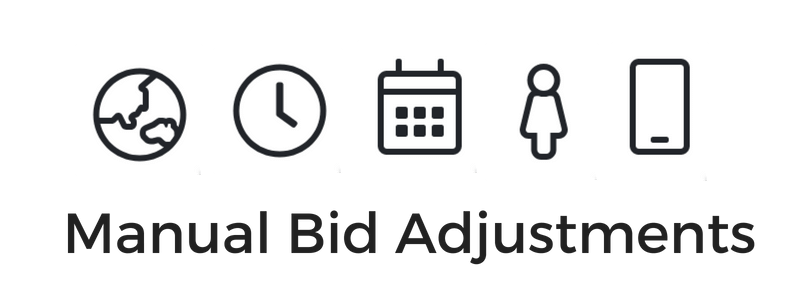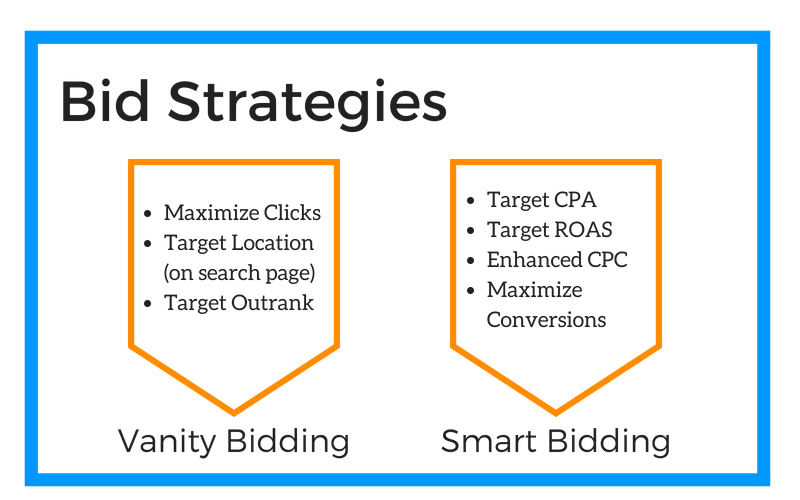 Bid management is not traditionally thought to be part of a marketing job so why do so many search marketers manage a handful of bids? How did bid management creep into the job description?
Bid management is not traditionally thought to be part of a marketing job so why do so many search marketers manage a handful of bids? How did bid management creep into the job description?
I believe the task rose out of necessity because when pay-per-click (PPC) took off in the early 2000s, ad platforms spoke a different language than their advertisers. Where AdWords (now Google Ads) wanted advertisers to set a maximum cost per click (CPC), the companies advertisers represented were more concerned with driving visibility, making sales and getting leads. These were things better defined through a target rank, cost per acquisition (CPA) or return on advertising spend (ROAS).
To bridge the disconnect, the people managing the accounts had to do the math to convert business goals into the type of bids Google needed. And that’s why managing bids became a core part of search marketing.
Fast forward 18 years and I feel it’s time to stop managing bids manually. In this post, I’ll cover the easiest automated bidding options to start with and in part 2, I’ll cover the most common automation pitfalls to avoid.
The rise of automated bidding
Where once bid management was as simple as setting a maximum CPC, things got more complex over time as Google introduced new levers for bid adjustments to control bids for dayparting, geographic locations, devices, demographics and now, custom audiences. With that many possible adjustments, a single keyword alone could need upwards of 10,000 bids to account for every possible scenario!

This is more than the average person can handle, so it makes sense to get help from computers, especially now that machine learning has started to produce very good results for automated bidding. The search engines use their vast troves of data from watching what happens to ads that appear next to billions of searches to predict the right bid for new searches. Those search systems are constantly evolving based on how well predictions are matched in the real world.
Should I do manual bidding?
There is absolutely no scenario I can think of that warrants full manual bid management. But automating your bids is not as simple as throwing a switch. You need to consider different options for automating, both free solutions offered by the engines as well as those from third-party vendors like Marin, Kenshoo, Acquisio and Optmyzr (my company).
You could even use Google Ads scripts to do bid management or macros in a spreadsheet to record and replicate your process. Each solution uses different methodologies and has different degrees of automation. Some are more black box and others more transparent and can take additional inputs from advertisers to improve performance.
I believe there is a significant role for humans to play in bid management, but that role is not to manage CPCs manually. Here what we can focus on:
- Selecting the appropriate automation.
- Implementing the solution and the required tracking.
- Monitoring operations.
- Tweaking targets to better align with the needs of the advertiser.
Bid strategies from Google Ads
Most advertisers’ first foray into bid automation will likely be through one of Google’s free bid strategies that are part of the Google Ads platform. These bid strategies have been known by a variety of names in the past, for example, what is now called the Target CPA strategy used to be known as Conversion Optimizer. And what is now known broadly as “bid strategies” used to be called Flexible Bid strategies.
There are seven strategies currently available, four of which fall under a subset Google calls Smart bidding. The other three don’t have a special name and while we won’t refer to them as “dumb bidding,” they tend to have less to do with the bottom-line of advertisers and more with vanity goals, so perhaps they are not that smart.

Bid strategy types
Looking at the image above, the first three Vanity bid automations don’t operate in real-time but rather update bids periodically. Bids are set to what Google believes is needed to achieve the desired outcome in simulations using historical data. Let’s look at each.
Maximize clicks. Unless you’re purely a brand-focused advertiser and you don’t care about anything besides visits to your landing page, you have to track conversions if you hope to stand any chance of being a competitive search advertiser. But, if for some reason, you can’t install conversion tracking codes, you can still let Google drive as many clicks as possible for your budget. There’s no guarantee they will be good clicks, but they are eyeballs to your site.
Target search page location. To increase your ad’s visibility and its position in the search results at the top of the page or on the first page, you can opt to use the Target Search Page Location bid strategy. This can be set to raise and lower bids to stay at the recommended level or it can be used to assist those doing manual bid management to ensure manual bids don’t go below the levels needed to maintain the desired location on the page. This automation especially has merits when you’re starting out with new ads and you want to make sure you’re getting enough exposure to accumulate data. Once that data is in hand, you can eventually automate things further.
Target outranking share. This strategy works to automatically raise or lower bids to stay ahead of a competitor. It will try to outrank the other ads for the desired percentage of auctions where both advertisers are competing. However, as we all know, the final placement doesn’t solely depend on rank, so don’t take that outranked placement as a given. Specifically, budget limits can cause this strategy to show limited results.
Everyone loves to consider what would happen if all advertisers used this strategy since everyone’s bids will be raised as high as possible and the advertiser with the highest resulting ad rank wins.
Keep in mind the bids are raised at the keyword level and this can impact auctions where the domain you want to outrank is not even participating (e.g. because they used some additional negative keywords).
Smart bidding
Smart bidding is a subset of bid strategies and contains four conversion-focused goals. It uses the latest machine learning models to predict which factors of an auction are likely to lead to differences in conversion rates and value-per-click and uses this to set the right bid for every auction.
Target CPA. Through the use of machine learning and using historical information from your campaign, this smart bidding strategy optimizes your bids to get as many conversions as possible at your average target cost per acquisition (CPA). It’s important to understand this means some conversions can be above the target CPA as long as there are others that are lower so the average comes close to the target. You need to understand how to group things together or how to build portfolios. I’ll cover how to think about standard versus portfolio strategies in just a minute.
Target ROAS. This strategy sets bids to maximize conversion value or revenue (depending on what data you are submitting to Google with the conversion) while averaging to a target return on ad spend (ROAS). While this strategy requires just 15 conversions in the past 30 days, Google recommends you have at least 50 consistent conversions. So if performance changes frequently because you have various sales and promotions running, this strategy may not work well.
Maximize conversions. This strategy is similar to Target CPA in that it tries to drive the most possible conversions. However, unlike Target CPA where the CPA is the value that limits bids, here, the budget is the limiting factor. A Target CPA strategy may not spend the entire budget if it can’t find enough conversions that average to the target. The CPAs may get higher and higher until the whole budget is gone. So if it’s more important to spend the whole budget than to stay within a certain CPA, this is the automation to use.
Enhanced cost per click. This smart bidding strategy helps you reach a higher number of conversions by raising or lowering your bid in cases where the algorithm believes that a specific search is more or less likely to lead to a conversion. It will try to keep the average CPC under your max CPC, but in some cases, the individual bids could significantly exceed the maximum. This is the only smart bidding automation that still lets advertisers set all bid adjustments. The system will change the final bid after all adjustments are added to the starting manual bid.
With some of the automations, the advertiser gets to choose between applying a portfolio bid strategy or a standard bid strategy.

Standard strategies
A Standard bid strategy is one that is applied to a single campaign. The items inside the campaign will be treated as a portfolio. If multiple campaigns using standard strategies have the same target, they would still be treated as separate portfolios. This means that if one campaign has a hard time meeting the target, it won’t be able to use a more successful campaign to balance out results.
When to use a standard strategy. When it’s not desirable to let results be blended, use a standard bid strategy. For example, don’t combine your branded campaign with a non-branded campaign because they will likely convert very differently and may have very different targets. By using standard strategies, you prevent the difference between how much you’re willing to pay and how much you’re actually paying from being re-allocated to other parts of the portfolio.
If you have a $20 CPA goal and the brand campaign brings in leads at $5 each, do you want the $15 difference between the target and the actual to be used to buy $35 conversions in a non-brand campaign?
Portfolio strategies
In a portfolio strategy, several campaigns that share the same goal can be treated as a group, or a portfolio. When multiple campaigns are part of a single portfolio, it means that a better performing campaign can subsidize a worse performing campaign if that helps drive more conversions.
When to use a portfolio strategy. Portfolio bid strategies are a good option if you have multiple campaigns that sell similar things with the same target goal.
For example, if you’ve broken out your Google Ads account to sell t-shirts into campaigns for “cotton t-shirts” and “poly-blend t-shirts”, it may be okay to give them a similar target CPA and let them share data through a portfolio.
Conclusion
Machine learning has come a long way since Google first started using it in AdWords to calculate Quality Score. Now it can handle a variety of bid management scenarios and automate the tedious work humans used to do to calculate the CPC bid based on business goals.
But as wonderful as the varying levels of bid automation are, humans are still very much needed to drive successful outcomes. In the second part of this series, I will cover how PPC pros are critical to preventing some of the most common pitfalls of automated bidding.
Want more info on Paid Search? Check out our comprehensive PPC Guide – Nine chapters covering everything from account setup to automation and bid adjustments!
Contributing authors are invited to create content for Search Engine Land and are chosen for their expertise and contribution to the search community. Our contributors work under the oversight of the editorial staff and contributions are checked for quality and relevance to our readers. The opinions they express are their own.



